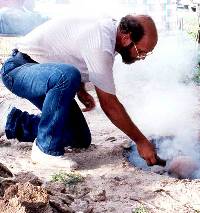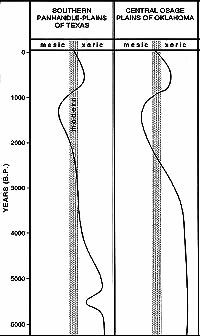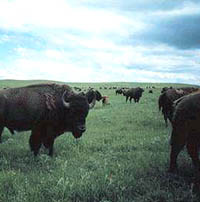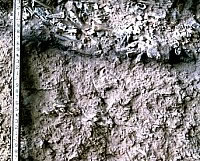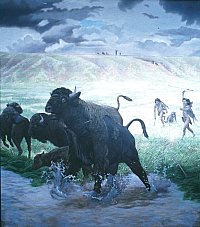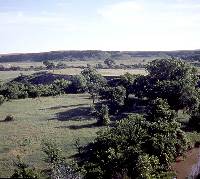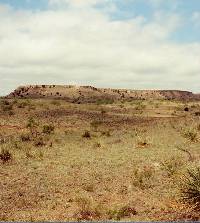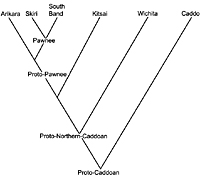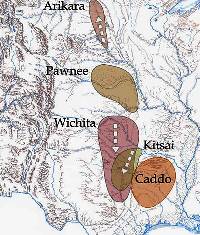Who lived at Buried City?
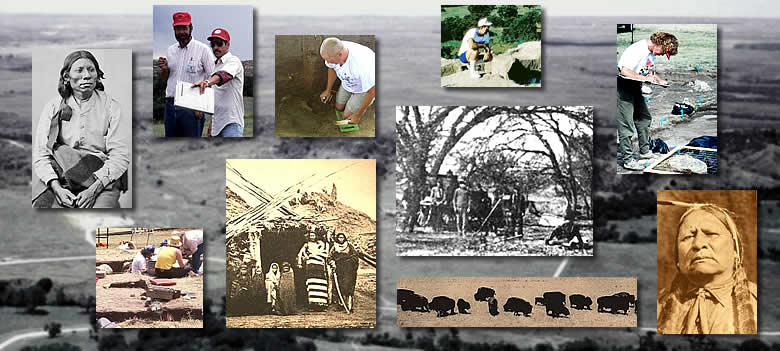
|
In this interpretive essay, David Hughes takes a big-picture look at Buried City: who lived there and when, where, why and how? Big-picture understandings of the human past are the hardest of all to see with clarity, especially when expressed in typical, qualify-everything academic writing. Here David takes a more personal and direct approach. Archeology is many things. It is the study of the past, the scientific study of the past, the science of the past, and the humanities thread that weaves the social sciences, the hard sciences, and the arts into a common fabric. All of these elements are present in the archeological history of Wolf Creek, from the early exploratory searches of Eyerly to the efforts by Moorehead to find on the Plains the predecessors of the Pueblo Cliff-Dwelling peoples. Fewkes' and Ellzey were looking for that most elusive of things: information. My own investigations sought to find and understand the Buried City of published and contemporary legend. The ongoing work by the University of Oklahoma seeks new scientific data to test hypotheses about suspected cultural connections across the Southern Plains. These are among the varieties of archeological practice, past and present. Yet there is a common thread that ties them all together. It is a thread spun from the human condition that weaves perpetually through the minds of those drawn to the past by something they have seen, heard, or thought about the people of the past. The strands of the thread are as many as those whose lives it touches, but its basic elements are known to every social studies teacher, practicing archeologist, and museum receptionist. When people encounter strange things from the past that they can see are human in origin, most ask first: Who were they? The next questions are almost as predictable: Where did they come from? When were they here? Why did they leave? Where did they go? When we examine Buried City's investigators and their motives from any time, we see that these basic human questions also have driven the archeology along Wolf Creek. In this exhibit we have tried on several levels to answer these questions. Although they are of few words, the questions are not as simple as they may sound. Who were they? This question can be meant narrowly or broadly. Archeologically, we cannot now or ever know the names of the individuals who lived at Buried City, one facet of "who." Because the modern forms of the organized Indian tribes seem to have taken shape only in the recent past, we cannot even say what tribe or ethnicity these people would have identified themselves with, another facet of "who." Yet we can tell a bit of the story about how they lived, what their homes were like, and hints of some of their choices, entertainment, adornment, diet, tools, and other things. We know that they had their own ways of building houses and made their clay pots different in subtle and great detail from those of their neighbors. We know they were farmers, hunters, and gatherers, that they raised families and had homes of some permanence. This is certainly all part of the "who" question, but is at times quite unsatisfying. Is that all there is that we can know? Each of us carries our past with us in this world, and the same was true of the prehistoric people of Wolf Creek. We don't know from whence they came with any certainty, but archeologists have detected some suggestive patterns. Going well beyond Wolf Creek, and well before the Buried City in time, changes were afoot on the Southern Plains more than a millennium before Julius Cesar ruled Rome. About 3,500-4,000 years ago a long era of warm and dry climatic conditions (sometimes called the Altithermal) came to an end as the climate gradually shifted toward recognizably modern conditions. With cooler temperatures and more rainfall, the grasslands of the Great Plains flourished and bison herds expanded their numbers and their range. People weren't far behind, moving westward into the Plains from the Eastern Woodlands, eastward from the Rocky Mountains, southward from the Edwards Plateau, and probably from other directions as well, drawn by the buffalo and more moderate conditions. A dramatic archeological deposit in Bonfire Shelter near present-day Langtry, Texas, dating to about 800 B.C. (2800 years ago) shows unambiguous evidence of the result of the expansion of grasslands, of bison, and of bison hunting in the Southern Plains. There, as many as 800 buffalo were driven off a cliff by Late Archaic hunters in one or several closely spaced episodes . By 2000 years ago, bison hunting had became a common way of life in the Southern Plains and on the Llano Estacado. But then the climate shifted back toward warmer/drier conditions and bison numbers once again thinned. These changes were likely gradual, intermittent, and cumulative in nature, rather than continuous and abrupt, although it must have felt abrupt the year the bison herds did not return. By about 1500 years ago the peoples whose ancestors had hunted the buffalo had adopted a more sedentary foraging and gathering life, supplemented by deer hunting (Plains Woodland cultures). The different traditions they had brought with them to the hunt and had acquired in centuries of chasing the bison were the foundation for their new lifestyles. As they settled into the wooded and well-watered valleys on the Plains, each community had a unique blend of attitudes, ideas, and knowledge. Communication among groups was reduced, simply because people were staying in one place for longer and taking advantage of local resources. To be sure there was still some exchange of materials and information across the High Plains, but less than there was before and would be again during the bison-rich eras. The people living in each small valley followed their own traditions to which they added new ideas and things like pottery making, horticulture, and building durable structures. From this mix, the people of Buried City and the many surrounding small-scale cultures developed and flourished. About 800 years ago (A.D. 1200) or so, climatic conditions had once again improved and soon a lifestyle based on bison hunting was again feasible. Plains groups were probably on the move exploring new places, new ways, and now-new peoples they had once known in legendary times. The presence of bison herds was fundamentally important: across the world, intensive farming societies have been allied historically with pastoral societies in a near symbiotic relationship exchanging grain, labor, and manufactured goods for hides, meat, and other animal products. There were no large domesticated animals in North America, but bison hunting was the next best thing—maybe even better because they took care of themselves. This was Buried City's heyday, a several-century period during which bison herds regularly ranged the Texas Panhandle and dry-land corn farming was successful more often than not in the wooded and well-watered valleys. But this lifeway didn't last long and probably no later than A.D. 1400, and certainly, by A.D. 1450, people abandoned Wolf Creek. Over the next century they apparently returned sporadically to hunt, revisit important places, and perhaps even tried to resettle the valley. If so, the resettlement effort was unsuccessful and Wolf Creek became just another stopping place for the later Plains nomads groups that took over the Texas Panhandle during the 15th and 16th centuries. We don't know precisely why the Buried City people left, but the classic reasons given for any precipitous abandonment of a region include: drought, crop failures, war, floods, and other more idiosyncratic reasons. One little-considered possibility is that which we can see effecting under-industrialized towns across northwest Mexico today: deforestation. Without firewood, homes cannot be heated in the winter, food remains raw, and hides can't be smoked for waterproofing. Without wood for walls and roof supports, no new homes can be built, there isn't spare wood to build racks for drying hides or to use as arbors to stave off the summer heat. I think it likely that the Buried City people occupied a timbered oasis in the semi-arid sea of grass 800 years ago and after only 8 or 10 generations, perhaps 250 years, the wood and other resources that lured people here had been depleted. They had no choice but to move. We can also see some other interesting possibilities. Elsewhere on this website is a discussion of the history of Caddoan-speaking peoples. There the results of a dating technique known as glottochronology (estimating tongue-time, if you will) are summarized. If these estimates are right, the speakers of the Northern Caddoan languages split off from the Southern Caddoans (Caddo proper) at about 3,500 years ago: the very time during which the Plains saw a revival of bison hunting that may have enticed outsiders to move to the prairies. The onset of the Woodland period (and coincidentally the end of the bison hunting for the time being) at about 1500 years ago happens to be about the same time the Wichita speakers split from the speakers of other Northern Caddoan languages (Pawnee, Arikira, and Kitsai). You can, perhaps, see where I am going with this. I should pause to admit that my interest in such broad parallels in culture and biology and in the history of the Caddoan language family has a genetic link. My father, Jack T. Hughes, wrote his dissertation on the Prehistory of the Caddoan-speaking Tribes (Columbia University, 1968) and tried to trace Caddoan peoples through time and across space. But even he dared not draw historical connections with such a broad brush for such a significant span of time (at least not in print). Mindful that I am skating on thin, speculative ice, I offer the following scenario of how the Buried City may have come to be, where its people came from, why they left, and where they are now. At the end of the long drought or Altithermal, the Great Plains regained its character as an inviting sea of grass, and bison began returning in numbers unprecedented in living memory. Hunters and foragers from the Plains margins, east, west, and south, were quick to take advantage of the much-improved situation and abandoned their root-baking pits, fish weirs, and deer nets to seek their lives on the buffalo prairies, just as protohistoric Puebloan peoples did annually. They began on the margins of the Plains where they could find the basic necessities with which they were familiar and moved farther and farther out on to the Plains. There they met others whose ancestors had stayed on the Plains and still others who came from the opposite direction. These born-again hunters probably formed a multitude of different groups, sharing a common purpose and direction: making a living off the bison. It does not seem unreasonable to suggest that, in such circumstances, diverse groups would have rapidly adopted the same material culture (types of tools and ways of making things), as did the historic Plains nomads who came from all directions to hunt the buffalo after A.D. 1700. The chases of these Late Archaic hunters took them up and down the Plains as far as the buffalo could go and, when the buffalo again ran out, they settled to the well-watered stream valleys and took up their remembered old ways of foraging and small-game hunting in a new place with new game and new plants. They continued this way, growing in place, to become the classic Plains margin dwellers of Antelope Creek, the people who lived in Hank's house north of the Canadian River, the Buried City people, and the people of other archeological Plains Village cultures from south-central Kansas west to Shattuck, Oklahoma, south across the Red River, and then finally east to the north Texas area with the Henrietta complex. As they settled into their valleys, the Plains villagers developed local customs based upon those they remembered from elder times, those they had acquired from travelers and sojourners who joined their group, and those they needed to survive in their particular place. These ideas shared a common cultural root or what anthropologist Julian Steward called a "culture core," and so reflect strong degrees of similarity, and yet differences are also abundant because of isolation, local changes, and idiosyncrasies enhanced into local cultural traditions. Through time, our traveling people, Caddoan-speakers I think, who had moved west from the Caddo Homeland in eastern Texas and Oklahoma, began to grow and prosper in their new land. They kept their communication with old friends and kin and so traded ideas and materials up and down the margin of the High Plains. When the buffalo returned, about 700-800 years ago, they took advantage of the newly available food source and grew more prosperous and numerous, they traded more, and they became inordinately fond of corn, which they grew in their protected valleys. The ancestors of Woodland gardeners were rapidly becoming true farmers and village dwellers. No sooner had this process been well begun than it ended all across the southern Plains. The abandonment of Buried City may have anticipated other areas because of the exhaustion of wood and other local resources, but that cannot explain the regional pattern. The people of Buried City and other Southern Plains villages are the likely ancestors of the Northern Caddoan or Plains Caddoan peoples: the Wichita, Pawnee, Arikara, Kitsai, and others whose names are lost in time. Who were the people of Buried City? Traces of them can be found in all of these modern peoples. Where did they come from? They came from elsewhere (mainly to the east) to arrive here. They followed the herds, their dreams, and, no doubt, the rich stories of their elders to get here. Why did they leave? I really wish I knew for sure. But, then, isn't that part of what keeps us coming back to the past? Trying to answer just one more question? David T. Hughes |
|
